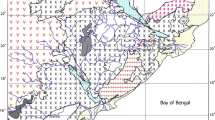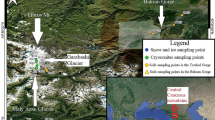Abstract
This paper, with Milanggouwan stratigraphic section as a typical section of the Salawusu River Basin, explores the relation between CaCO3 content distribution and climate change since 150 ka B. P. and concludes that: 1) The low-high changes of CaCO3 content in the section has a remarkable corresponding relation with the sedimentary cycles of ancient aeolian sand and overlying fluviolacustrine facies or palaeosols. 2) CaCO3 distribution in aeolian sand is relatively meagre, ranging from 0.8% – 7.18%, or on an average 2.50 % but relatively enriches in the fluviolacustrine faceis and palaeosols, ranging from 2.20% – 14.9%, or on an average 5.74%. This implies that they have different climatic backgrounds. The former was the product of erosion, transport and deposition by wind under arid and cold climatic conditions, whereas the latter was related to its special low-lying geomorphic position between the Ordos Plateau and Loess Plateau and warm-humid climatic environment. When the climatic became warm and humid, fluviolacustrine and swamp facies developed, soil-forming action strengthened, and low-lying catchment condition was favorable to CaCO3 accumulation. 3) The basic cause responsible for the multicycle of CaCO3 migration and accumulation in the Milanggouwan section may be the multiple alterations of winter and summer monsoons over the Mu Us Desert under the influences of climatic fluctuation of glacial and interglacial periods in the Northern Hemisphere since 150ka B.P..
Similar content being viewed by others
References
DONG Guang-rong, GAO Shang-yu, LI Bao-sheng, 1982. New discovery of Hetao Man fossils[J]. Chinese Science Bulletin, 26(19): 192–194. (in Chinese)
DONG Guan-rong, LI Bao-sheng, GAO Shang-yu, 1983. Vicissitudes of Mu Us Desert since Late Pleistocene viewed from the strata of Salawusu River Basin [J]. Journal of Desert Research, 3(2): 9–14. (in Chinese)
GAO Shang-yu, DONG Guang-rong, LI Bao-sheng et al., 1988. The content changes of CaCO3 and soluble salt in the strata and the climatic environments in arid and semi-arid region, as examplified by Salawusu River [J]. Journal of Arid Land Resources and Environment, 2(4): 222–229. (in Chinese)
GUAN You-zhi, CHEN Zhen-ying, JIA Hui-lan, 1986. Relation between element distribution in Quaternary strata in Salawusu River Basin and ancient climate[J]. Journal of Desert Research, 6(1): 32–35. (in Chinese)
JIA Lan-po, 1950. Hetan Man [M]. Shanghai: Longmeng Joint Book Company, 1–89. (in Chinese)
LI Bao-sheng, DONG Guang-rong, GAO Shang-yu, 1987. Relation between Malan loess and Salawusu Formation in the Salawusu River Basin of Ordos Plateau and their geological ages[J]. Acta Geologica Sinica, 61(3): 218–230. (in Chinese)
LI Bao-sheng, DONG Guang-rong, GAO Shang-yu, 1989. Upper Pleistocene strata and its evolution in the Salawsus River Vallay[J]. Geographical Research, 8(2): 64–73. (in Chinese)
LI Bao-sheng, DONG Guang-rong, WU Zheng, 1993. The establishment of the Upper Pleistocene Chengchuan Formation in Northern China[J]. Geological Review, 39(2): 91–100. (in Chinese)
LI Bao-sheng, JIN He-ling, LU Hai-yan, et al., 1998. Processes of the deposition and vicissitude of Mu Us Desert, China since 150ka B. P.[J]. Science in China (Series D), 41(3): 248–254. (in Chinese)
LINSLEY B, 1996. Oxygen-isotope record of sea level and climate variations in the Sulu Seaover the past 150, 000 years [J]. Nature, 380: 234–237.
LI Yan-xian, JI Hong-xiang, 1981. Environmental change in Peking Man’s time[J]. Vertebrata Palasiatica, 19(4): 337–347. (in Chinese)
QI Guo-qin, 1975. Quaternary mammal fossils in Salawusu River Basin of Inner Mongolia[J]. Vertebrate Paleontology and Paleoanthropology, 13(4): 239–249. (in Chinese)
SHAO Ya-jun, 1987. Pollen assemblage and the reflected ancient vegetation and climate in the Salawusu River Basin since Late Pleistocene [J]. Journal of Desert Research, 7(2): 22–27. (in Chinese)
SIN Jian-zhong et al., 1991. Quaternary Geology in the Loess Plateau[M]. Bei**g: Science Press, 161–168. (in Chinese)
SUN Ji-min, LIU Tong-sheng, DING Zhong-li, et al., 1996. The Mu Us Desert evolution in the last 0.5Ma[J]. Quaternary Science, 4:359–365. (in Chinese)
TEILHARD de Chardin P, LICENT E, 1924. On the discovery of a Paleolithic industry in Northern China [J]. Bulletin of the Geological Society of China, 3 (1): 45–50.
TEIHARD de Chardin P, YANG Zhong-jian, 1930. Stratigraphic observation of loess period after Pontian in west Shanxi and northwest Shaanxi [J]. Special Issue of Geology, A, 1(8): 15–17.
WEN Qi-zhong, et al., 1989. The Loess Geochemistry in China [M]. Bei**g: Science Press, 84–92. (in Chinese)
WEN Qi-zhong, DIAO Gui-yi, JIA Rong-fen et al., 1995. Geochemical records of Paleaoclimate Change in Loess Sections [J]. Quaternary Science, 3: 223–230. (in Chinese)
WU Ru-kang, 1958. Parietal bone and thighbone fossils of Hetao Man[J]. Acta Vertebrate Paleontologica Sinica, 2(1): 208–210. (in Chinese)
XIE Jun-yi, GAO Shang-yu, DONG Guan-rong, 1995. Salawusu fauna[J]. Journal of Desert Research, 15(4): 313–322. (in Chinese)
YUAN Bao-yin, 1978. Problems on sedimentary environment of Salawusu Formation and stratum division[J]. Geological Science, (3): 320–334. (in Chinese)
ZHANG Yu-hong, LI Bao-sheng, JIN He-ling et al., 2001. Grain-size cycles in Salawusu River Valley since 150ka B. P. [J]. Acta Geographica Sinica, 56(3): 332–344. (in Chinese)
ZHENG Hong-han, 1989. Late Pleistocene fluviolacustrine strata and aeolian loess in North China[J]. Geochemica, (4): 343–351. (in Chinese)
Author information
Authors and Affiliations
Additional information
Foundation item: Under the auspices of the National Natural Science Foundation of China (No. 49971009); State Key Laboratory of Loess and Quaternary Geology, Institute of Earth Environment, the Chinese Academy of Sciences (SKLLQG008) and National Key Project for Basic Research (G2000048701).
Biography: LUO Kai-li (1969 -), male, a native of Hengnan County, Hunan Province, master of science. His research interest includes environment and its evolvement.
Rights and permissions
About this article
Cite this article
Luo, Kl., Li, Bs., Zhu, Yz. et al. CaCO3 cycles in salawusu river basin since 150ka B.P.. Chin. Geograph.Sc. 11, 336–342 (2001). https://doi.org/10.1007/s11769-001-0049-6
Received:
Issue Date:
DOI: https://doi.org/10.1007/s11769-001-0049-6




